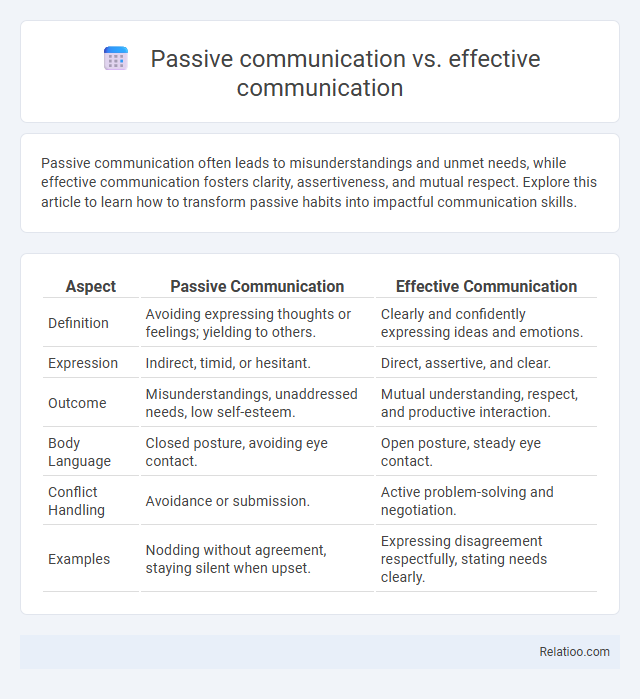Passive communication often leads to misunderstandings and unmet needs, while effective communication fosters clarity, assertiveness, and mutual respect. Explore this article to learn how to transform passive habits into impactful communication skills.
Table of Comparison
| Aspect | Passive Communication | Effective Communication |
|---|---|---|
| Definition | Avoiding expressing thoughts or feelings; yielding to others. | Clearly and confidently expressing ideas and emotions. |
| Expression | Indirect, timid, or hesitant. | Direct, assertive, and clear. |
| Outcome | Misunderstandings, unaddressed needs, low self-esteem. | Mutual understanding, respect, and productive interaction. |
| Body Language | Closed posture, avoiding eye contact. | Open posture, steady eye contact. |
| Conflict Handling | Avoidance or submission. | Active problem-solving and negotiation. |
| Examples | Nodding without agreement, staying silent when upset. | Expressing disagreement respectfully, stating needs clearly. |
Understanding Passive Communication
Passive communication is characterized by avoiding expression of personal needs or feelings, often leading to misunderstandings and unmet expectations. Effective communication involves clear, assertive expression, active listening, and mutual respect to foster understanding and collaboration. Understanding passive communication helps identify patterns of avoidance and empowers individuals to transition towards more assertive and productive interactions.
Defining Effective Communication
Effective communication is the clear and concise exchange of information where the sender's message is accurately received and understood by the recipient, fostering mutual understanding and collaboration. Passive communication, by contrast, often involves withholding thoughts or feelings, leading to misunderstandings and unexpressed needs. Unlike passive communication, effective communication employs assertiveness and active listening to ensure clarity and engagement between parties.
Key Characteristics of Passive Communicators
Passive communicators often avoid expressing their true feelings, opinions, or needs, leading to misunderstandings and unaddressed issues. They tend to prioritize others' desires over their own, resulting in low self-esteem and increased stress levels. Key characteristics include reluctance to say no, frequent apologies, and difficulty asserting boundaries or standing up for themselves.
Traits of Effective Communicators
Effective communicators exhibit traits such as active listening, clarity, and assertiveness, which distinguish them from passive communicators who often avoid expressing opinions and needs. They maintain open body language, provide constructive feedback, and engage in two-way dialogue, fostering mutual understanding. Unlike passive communication, effective communication involves confidently articulating thoughts while respecting others, promoting collaboration and resolution.
Causes of Passive Communication Styles
Passive communication often arises from fear of conflict, low self-esteem, or a desire to avoid confrontation, leading individuals to suppress their opinions and needs. Effective communication, in contrast, requires confidence, assertiveness, and clarity to express thoughts and feelings openly while respecting others. Understanding the causes of passive communication helps identify barriers such as anxiety, cultural conditioning, or lack of communication skills that hinder assertive expression.
Impact of Passive Communication on Relationships
Passive communication often leads to unresolved conflicts and diminished trust, negatively impacting relationship quality. Effective communication fosters clarity, mutual respect, and emotional connection by encouraging open expression of feelings and needs. Unlike passive communication, assertive communication promotes healthy boundaries and stronger interpersonal bonds, reducing misunderstandings and resentment.
Benefits of Practicing Effective Communication
Effective communication enhances clarity, reduces misunderstandings, and fosters stronger relationships by encouraging open and honest dialogue. Unlike passive communication, which often leads to unresolved issues and suppressed emotions, effective communication promotes active listening and assertiveness, enabling Your ideas and concerns to be clearly expressed. Practicing effective communication improves collaboration, boosts confidence, and supports problem-solving skills, ultimately benefiting both personal and professional interactions.
Common Barriers to Effective Communication
Common barriers to effective communication include misunderstandings, lack of clarity, and emotional interference, which can hinder message delivery. Passive communication often leads to unexpressed thoughts and unresolved conflicts, while aggressive communication may cause defensiveness and breakdowns in dialogue. Your ability to recognize and overcome these barriers fosters clearer, more productive exchanges and relationships.
Strategies to Transform Passive into Effective Communication
Passive communication often leads to misunderstandings, unresolved conflicts, and reduced self-esteem, while effective communication promotes clarity, assertiveness, and mutual respect. Transforming passive communication into effective communication requires strategies such as practicing assertiveness by expressing needs clearly, using "I" statements to take ownership of feelings, and actively listening to others without judgment. Regular feedback, building confidence through role-playing, and setting clear personal boundaries also help shift passive tendencies toward more constructive and impactful interactions.
Long-Term Outcomes of Effective Communication Skills
Effective communication fosters trust, clarity, and strong relationships, leading to long-term personal and professional success. Unlike passive communication, which may result in misunderstandings and unresolved conflicts, your ability to express ideas assertively enhances collaboration and problem-solving over time. Developing these skills promotes continuous growth and resilience, ensuring sustained positive outcomes in various aspects of life.

Infographic: Passive communication vs Effective communication
 relatioo.com
relatioo.com